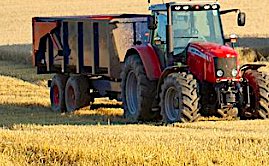Scotland’s 2017 cereal harvest is expected to rise 12% on 2016, almost fully recovering from last year’s poor results, the Scottish Government said.
Despite “less favourable” conditions in September, Scottish farms are estimated to produce 3.1 million tonnes of cereals this year, including 1.9 million tonnes of barley and one million tonnes of wheat.
The total is 8% up on the 10-year average.
The Scottish Government’s Chief Statistician has released the first estimates of the 2017 Scottish cereal and oilseed rape harvest.
“The figures show that this year’s expected increase in production is due to an eleven per cent increase in overall cereal yields,” said the Scottish Government.
” The total area of land sown is also expected to have risen by one per cent on last year, with an estimated 433,000 hectares of cereal grown in 2017.
“Overall yields are expected to average at a record high of 7.1 tonnes per hectare; ranging from 6.2 tonnes per hectare for spring barley to 9.0 for wheat.
“Spring barley, Scotland’s most important cereal crop, is expected to increase 16 per cent to 1.5 million tonnes, but still lower than in 2013 to 2015.
“The yield however is expected to be the highest recorded, at about 6.2 tonnes per hectare.
“Winter barley likewise saw a 13 per cent increase to 371,000 tonnes, with wheat increasing seven per cent to 988,000 tonnes.
“Oats saw a third consecutive increase, with record yields for the second year, and the crop expected to top 215,000 tonnes for the first time since the 1970s.
“Oilseed rape is expected to rebound from the particularly poor 2016 figures, with yields averaging over four tonnes per hectare, resulting in production at around 140,000 tonnes, slightly less than 2014 and 2015.”
The early estimates of the Scottish harvest come from the Scottish Government’s annual Crop Report Meeting.
Industry experts attending the meeting reported increases in yields on last year.
“Despite a dry spell in April and a wet harvest period, spring sowings were well established and moisture came at the right time to encourage growth,” added the Scottish Government.
“Moisture content at harvest is high, meaning that drying costs will have increased considerably this year.
“Scottish cereals are still being harvested and these figures are very much provisional estimates.
“Final harvest estimates from the Cereal Production Survey will be announced in December.
“Final estimates of overall cereal production are typically within five percent of the early estimates.”
